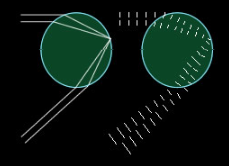Colorado Rainbows & Supernumeraries - OPOD
Colorado Rainbows & Supernumeraries - Exploring the Magical Phenomenon
Rainbows have always fascinated us with their vibrant colors and ethereal beauty. But did you know that rainbows can sometimes exhibit additional bands of colors within them? These mesmerizing features are known as supernumerary rainbows. In this article, we will delve into the captivating world of Colorado rainbows and supernumeraries, shedding light on the science behind these enchanting optical phenomena.
Understanding Supernumerary Bows
Supernumerary bows, as the name suggests, occur alongside the primary and secondary rainbows. While the primary and secondary bows are primarily caused by refraction, supernumeraries arise from a different optical phenomenon known as diffraction. This distinction gives them their unique appearance.
The Science Behind Supernumeraries
To comprehend the formation of supernumerary bows, we must consider the behavior of light rays passing through raindrops. At the edge of the rainbow, where the deflection angle is minimal, two rays merge. However, as the deflection angle increases within the rainbow, these rays start to separate. It is these diverging rays that create the distinct bands of colors characteristic of supernumeraries.
Wave Crests and Spacing
When raindrops are small, the behavior of wave crests along the ray paths becomes crucial. In certain directions, the crests become out of phase, resulting in a dark band. Conversely, other directions produce bright bands, which we perceive as supernumerary rainbows. The spacing between these bands depends on the size of the raindrops, with smaller drops leading to wider spacing.
Size Matters: Raindrop Influence
Supernumeraries are best observed when raindrops are relatively uniform in size. Drops that are similar in size result in more pronounced and well-defined supernumerary bows. In the captivating photograph of Colorado rainbows provided above, it is evident that the drops must be smaller towards the upper parts of the rainbow to produce such a striking display of supernumeraries.
The Role of Wavelength
The spacing of supernumeraries is also influenced by the wavelength of light. This can be observed in Airy function simulations, where the spacing between supernumeraries varies depending on the diameter of the raindrops. The resulting color overlaps give rise to supernumeraries displaying hues of green, purple, and even pink.
Unveiling the Magic: Simultaneous Rainbow Photography
Capturing simultaneous photographs of rainbows through different colored filters could provide intriguing insights into the behavior of supernumeraries. This novel approach may shed light on how these additional bands of colors manifest and interact with varying wavelengths of light. Such photographs, if successfully obtained, would not only be fascinating but also contribute to our understanding of this captivating atmospheric phenomenon.
Rainbows have captivated humanity for centuries, evoking a sense of wonder and enchantment. The discovery and exploration of supernumeraries within rainbows add another layer of intrigue to these already mesmerizing displays. By unraveling the scientific principles behind Colorado rainbows and supernumeraries, we gain a deeper appreciation for the intricacies of nature's optical marvels.

Colorado Rainbows & Supernumeraries ~ An evocative scene by Haitong Yu at NCAR, National Center for Atmospheric Research, near Boulder, Colorado, USA. The secondary bow at right has reversed colours to the primary and is much broader. Inside the primary are bands of greens and purples, more widely separated higher up. These are supernumerary rainbows. Image ©Haitong Yu, shown with permission
Supernumerary bows
Supernumeraries occur inside the primary and outside (but rarely) the secondary. The main bows are predominantly refraction effects. Supernumeraries arise from diffraction.

For any deflection angle, there are two rays passing through the rain drop. At the rainbow's edge - the minimum deflection angle - these two rays merge. At larger deflection angles, which show up inside the rainbow, the rays separate. These are the rays that form supernumeraries.
When raindrops are small the behaviours of wave crests along the ray paths becomes important. The schematic at upper right shows the crests out of phase. This would produce a dark band. Other directions produce a bright band - a supernumerary.
Supernumerary spacing depends on the raindrop size and so they show best when drops are more or less similarly sized. Small drops give a wider spacing. In the photo at top the drops must be smaller towards the upper parts of the rainbow.

Supernumerary spacing is also wavelength dependent as shown in this Airy function simulation for 0.7mm diameter drops. The considerable colour overlaps give supernumeraries of green and purple/pink hues.
Simultaneous (or near simultaneaous) pictures of rainbows like that above shot through blue and orange filters would be interesting - and maybe a first!
Note: this article has been automatically converted from the old site and may not appear as intended. You can find the original article here.
Reference Atmospheric Optics
If you use any of the definitions, information, or data presented on Atmospheric Optics, please copy the link or reference below to properly credit us as the reference source. Thank you!
-
<a href="https://atoptics.co.uk/blog/colorado-rainbows-supernumeraries-opod/">Colorado Rainbows & Supernumeraries - OPOD</a>
-
"Colorado Rainbows & Supernumeraries - OPOD". Atmospheric Optics. Accessed on November 26, 2024. https://atoptics.co.uk/blog/colorado-rainbows-supernumeraries-opod/.
-
"Colorado Rainbows & Supernumeraries - OPOD". Atmospheric Optics, https://atoptics.co.uk/blog/colorado-rainbows-supernumeraries-opod/. Accessed 26 November, 2024
-
Colorado Rainbows & Supernumeraries - OPOD. Atmospheric Optics. Retrieved from https://atoptics.co.uk/blog/colorado-rainbows-supernumeraries-opod/.